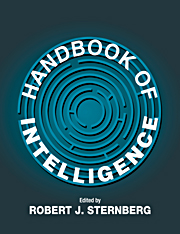Book contents
- Frontmatter
- Contents
- Preface
- Contributors
- PART I THE NATURE OF INTELLIGENCE AND ITS MEASUREMENT
- PART II DEVELOPMENT OF INTELLIGENCE
- PART III GROUP ANALYSES OF INTELLIGENCE
- PART IV BIOLOGY OF INTELLIGENCE
- PART V INTELLIGENCE AND INFORMATION PROCESSING
- PART VI KINDS OF INTELLIGENCE
- PART VII TESTING AND TEACHING INTELLIGENCE
- 19 Psychometric Approaches to Understanding and Measuring Intelligence
- 20 Tests of Intelligence
- 21 Interpretation of Intelligence Test Scores
- 22 Teaching Intelligence: A Performance Conception
- PART VIII INTELLIGENCE, SOCIETY, AND CULTURE
- PART IX INTELLIGENCE IN RELATION TO ALLIED CONSTRUCTS
- Author Index
- Subject Index
22 - Teaching Intelligence: A Performance Conception
Published online by Cambridge University Press: 05 June 2012
- Frontmatter
- Contents
- Preface
- Contributors
- PART I THE NATURE OF INTELLIGENCE AND ITS MEASUREMENT
- PART II DEVELOPMENT OF INTELLIGENCE
- PART III GROUP ANALYSES OF INTELLIGENCE
- PART IV BIOLOGY OF INTELLIGENCE
- PART V INTELLIGENCE AND INFORMATION PROCESSING
- PART VI KINDS OF INTELLIGENCE
- PART VII TESTING AND TEACHING INTELLIGENCE
- 19 Psychometric Approaches to Understanding and Measuring Intelligence
- 20 Tests of Intelligence
- 21 Interpretation of Intelligence Test Scores
- 22 Teaching Intelligence: A Performance Conception
- PART VIII INTELLIGENCE, SOCIETY, AND CULTURE
- PART IX INTELLIGENCE IN RELATION TO ALLIED CONSTRUCTS
- Author Index
- Subject Index
Summary
INTRODUCTION
For years, scientists studying fish movement were puzzled. Their accumulated knowledge of the flow characteristics of a fish moving through water accounted for only a third of the speed at which scientists knew fish could actually swim. Recently, in broadening their investigation of possible causal factors by creating a robotic fish that swam for long time periods, they learned that a fish creates vortices as it moves and can push off from those vortices. Suddenly the performance of the fish made sense; they understood how the fish and the medium interact to explain how fish swim as fast as they do.
What has fish movement got to do with teaching intelligence? A lot actually. The perspective shift that scientists underwent to create a more powerful explanatory model is similar to the shift in current educational efforts to teach for intelligence. Historically, theorists and educators sought models to explain and teach for intelligence that focused on individual capability. Although such efforts met with limited success on some measures, a great deal of the variance in actual intelligent performance remained unexplained and unchanged. Current efforts are beginning to reflect (1) a performance conception of intelligence as a standard for explanation, and (2) a broadened vision of what it takes to teach for intelligent performance. These efforts adopt a more systemic approach and consider how the propensities, current understandings, and actions of individuals and the supporting structures of environments interact to result in intelligent performances.
- Type
- Chapter
- Information
- Handbook of Intelligence , pp. 492 - 516Publisher: Cambridge University PressPrint publication year: 2000
- 13
- Cited by

